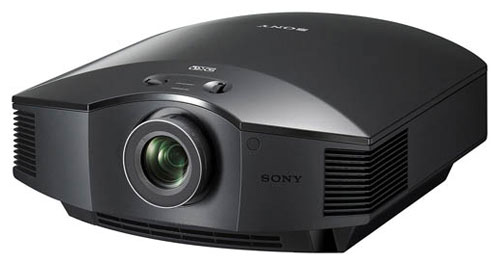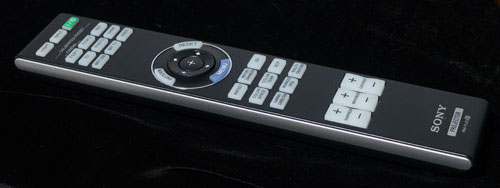With HDTVTest’s projector reviews now in full flight, it’s time for us to take a look at one of Sony’s efforts. This time, it’s their current mid-range LCOS projector, the Sony VPL-HW50ES, which sits in the middle of the company’s 1080p LCOS lineup. That places it inbetween the entry-level VPL-HW30ES and the VPL-VW95ES.
Compared to the HW30, the HW50 adds Dark Frame Insertion (which we’ll talk about at length), advanced Gamma calibration features (although accessing these is a little complicated), and “Reality Creation” processing, which Sony appears especially keen to promote. On the other end of the scale, compared to the higher-end VW95ES, the HW50 lacks motorised focus, zoom, and lens positioning (and accordingly, the lens memory feature), which will give it a convenience edge in setups where multiple aspect ratios can be accommodated.
Like the other projectors we’ve reviewed recently, the price of the VPL-HW50ES in the UK is under £3000 at the time of writing. Let’s see if it can compete in this increasingly sweet price point.
| Display Technology | SXRD (LCOS) |
| Lamp Product Code | LMP-H202 |
| Lens Shift | Manual H+V |
The Sony VPL-HW50ES is a fairly boxy-looking unit with a curved top, and is available in black (VPL-HW50ES/B) and white (VPL-HW50ES/W). Our preference would always be for black, which fits in better in a serious home cinema environment. The front of the unit looks a little unusual, since the lens looks almost like it belongs on a smaller projector. Anyway, the HW50ES’s design is fit for purpose, especially considering that as a projector, we’re not going to spend much time looking at it anyway.

The top of the unit has manual lens shift controls, which allow the image to be shifted both horizontally and vertically. Zoom and focus are achieved by manually turning the lens dials. The lens controls are fully manual rather than motorised.

Sony’s remote control is excellent, and comes styled in black with blue backlighting. It contains discrete selection of inputs and picture modes, and has a grooved back which makes it feel good to hold. Once installation is complete, though, most users should have little reason to interact with the remote beyond using the Power button (there’s one on the projector too).
 |
| Side connections on Sony VPL-HW50ES |
The VPL-HW50ES features no less than 9 picture modes, which Sony has called [Calibrated Presets] on this model. We’re unsure if these actually have been calibrated at the factory, or if the wording here is purely for marketing purposes, but we’ll be measuring the greyscale, gamma and colour being shot out of the HW50’s lens in just a minute to see how close they come to the video standards. There are a couple of other modes, such as “Bright Cine” and “Bright TV” designed for use in compromised viewing environments (although a projector of this quality deserves to be placed in at least a somewhat light-treated room). The “Reference” mode is the one designed to reproduce accurate video.
![[Picture] menu](https://www.hdtvtest.co.uk/news/wp-content/uploads/2018/04/hardware_Sony-VPL-HW50ES_picture.jpg) |
| [Picture] menus |
The first [Picture] menu houses controls for [Reality Creation], which has been shuffled to near the top of the menu. We’ll talk about this video processing in-depth later in the review.
Below this comes [Cinema Black Pro], which lets us adjust the lamp power (Low and High) as well as the [Advanced Iris], which has two severity levels, an off switch, and also a manual iris control.
Next, [Motionflow]. This gives control over dark frame insertion (called [Film Projection] – more on this later) as well as the [Motion Enhancer], which is a motion interpolation mode. That could be fairly harmless with video content, but as with all interpolation modes, it robs 24fps films of their cinematic look (no thanks).
![[Expert Setting] menu](https://www.hdtvtest.co.uk/news/wp-content/uploads/2018/04/hardware_Sony-VPL-HW50ES_adv.jpg) |
| [Expert Setting] menus |
The basic video processing adjustments follow, with [Expert Setting] housing some noise reduction controls (not a good thing if your input is from a high quality source, such as BD), selection of a [Gamma Correction] preset, and a [Color Space] control (not surprisingly, “BT.709” is the best starting point; since it refers to the same standards document also known as Rec.709). Back up a level, there’s a [Color Temp.] control, which allows various white points to be chosen (D65 being the best non-calibrated preset mode for colour video content), and five “Custom” memories which allow 2-point Greyscale to be independently configured.
![[RCP] menu](https://www.hdtvtest.co.uk/news/wp-content/uploads/2018/04/hardware_Sony-VPL-HW50ES_cms.jpg) |
| [Real Color Processing] menus |
Sony’s colour management processing is called “Real Color Processing” and is housed in a separate menu, independent to the other picture settings. This is a little strange, and it does mean that if you calibrate the VPL-HW50ES for 3D colour performance as well as 2D, you need to manually switch modes (Sony’s engineers were very receptive to a suggestion to automate this in the future). The RCP menu has three memory modes, each of which give three-axis (hue/saturation/luminance) control over all six primary and secondary colours. There’s also an “Off” setting which simply gives you the default colour properties.
Obviously, colour reproduction is also weighted by the [Color Space] selection in the standard Picture [Expert Setting] screen.
| Jump To: 1. DesignNext: Calibration3. Picture Quality |
jQuery(document).ready(function($) { var toc = $("#tableofcontents").html(); $("#tablecontents").html(toc); });